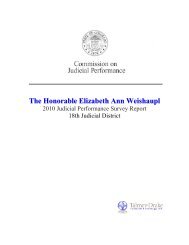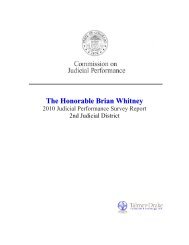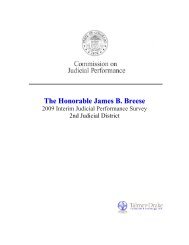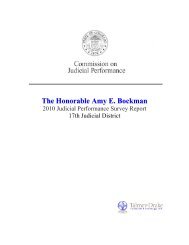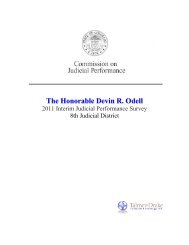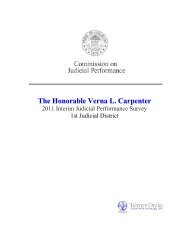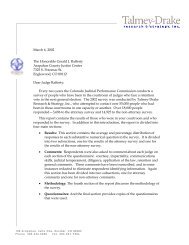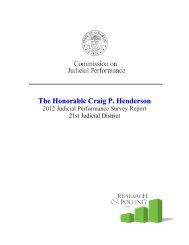Judge Christine Chauche - Commissions on Judicial Performance
Judge Christine Chauche - Commissions on Judicial Performance
Judge Christine Chauche - Commissions on Judicial Performance
You also want an ePaper? Increase the reach of your titles
YUMPU automatically turns print PDFs into web optimized ePapers that Google loves.
State of Colorado LogoCOMMISSION ON JUDICIAL PERFORMANCEThe H<strong>on</strong>orable <str<strong>on</strong>g>Christine</str<strong>on</strong>g> <str<strong>on</strong>g>Chauche</str<strong>on</strong>g>2012 <strong>Judicial</strong> <strong>Performance</strong> Survey Report18th <strong>Judicial</strong> District
March 26, 2012The H<strong>on</strong>orable <str<strong>on</strong>g>Christine</str<strong>on</strong>g> <str<strong>on</strong>g>Chauche</str<strong>on</strong>g>Arapahoe County Courthouse1790 W. Littlet<strong>on</strong> Blvd.Littlet<strong>on</strong>, CO 80120Dear <str<strong>on</strong>g>Judge</str<strong>on</strong>g> <str<strong>on</strong>g>Chauche</str<strong>on</strong>g>:I am pleased to make available to you the attached copy of your 2012 <strong>Judicial</strong><strong>Performance</strong> Survey Report. This report includes the survey results from twoimportant stakeholder groups: 1) attorneys who have had cases in your court or whoare knowledgeable about your judicial performance; and 2) n<strong>on</strong>-attorneys who haveobserved your performance in court or who have knowledge of your performance asa judge. In additi<strong>on</strong> to this introducti<strong>on</strong>, the report is divided into five main secti<strong>on</strong>s:1. A brief summary of the results of the attorney and n<strong>on</strong>-attorney surveys.2. The numerical results of the survey of attorneys in both tabular and graphicalform. In additi<strong>on</strong> to the numerical results, this secti<strong>on</strong> also c<strong>on</strong>tainscomments attorneys made about your judicial performance. In someinstances the comments have been redacted to eliminate resp<strong>on</strong>dentidentifying informati<strong>on</strong>. A copy of the attorney questi<strong>on</strong>naire is included inthe final secti<strong>on</strong> of this report.3. The numerical results of the survey of n<strong>on</strong>-attorneys in both tabular andgraphical form. In additi<strong>on</strong> to the numerical results, this secti<strong>on</strong> also c<strong>on</strong>tainscomments these resp<strong>on</strong>dents made <strong>on</strong> the subject of your judicialperformance. In few instances the comments have been redacted to eliminateresp<strong>on</strong>dent identifying informati<strong>on</strong>. A copy of the n<strong>on</strong>-attorneyquesti<strong>on</strong>naire is included in the final secti<strong>on</strong> of this report.4. The fourth secti<strong>on</strong> of the report discusses the methodology of the surveys.5. The final secti<strong>on</strong> provides copies of the questi<strong>on</strong>s or questi<strong>on</strong>naires that wereused for each survey.
H<strong>on</strong>. <str<strong>on</strong>g>Christine</str<strong>on</strong>g> <str<strong>on</strong>g>Chauche</str<strong>on</strong>g>March 26, 2012Page 2If you have any questi<strong>on</strong>s about the methodology and how the survey wasc<strong>on</strong>ducted, please feel free to c<strong>on</strong>tact me at 505-821-5454 or by email atsanderoff@rpinc.com (please put the words “<strong>Judicial</strong> <strong>Performance</strong>” in the subject line),and for any other questi<strong>on</strong>s you might have about the survey please call theExecutive Director of the Office of <strong>Judicial</strong> <strong>Performance</strong> Evaluati<strong>on</strong>, Jane Howell, at303-866-6465.Best regards,enc:Brian SanderoffPresident5140 SAN FRANCISCO RD NE, ALBUQUERQUE, NM 87109WWW.RPINC.COM 505-821-5454
Summary of ResultsResp<strong>on</strong>dents rated judges <strong>on</strong> various questi<strong>on</strong>s using an A to F scale, in which thegrades were then c<strong>on</strong>verted to numerical scores: A= 4, B=3, C=2, D=1 and F=0. Anaverage score of 4.0 is the highest possible score and a 0.0 is the lowest possible score.On average, <str<strong>on</strong>g>Judge</str<strong>on</strong>g> <str<strong>on</strong>g>Christine</str<strong>on</strong>g> <str<strong>on</strong>g>Chauche</str<strong>on</strong>g> received an overall combined average grade of3.28 in the 2012 <strong>Judicial</strong> <strong>Performance</strong> Survey. This is calculated by adding the overallaverage grade received from attorney resp<strong>on</strong>dents, 3.18, to the overall average gradereceived from n<strong>on</strong>-attorney resp<strong>on</strong>dents, 3.37, divided by two.The average combined grade for all county judges standing for retenti<strong>on</strong> in 2012 is 3.45[not shown below].<str<strong>on</strong>g>Judge</str<strong>on</strong>g> <str<strong>on</strong>g>Chauche</str<strong>on</strong>g> Average Grades (All Years)Combined Attorney N<strong>on</strong>-attorneyOverall Grade 3.28 3.18 3.37Sample Size - 91 251Table 1The results presented in this report are based <strong>on</strong> data collected in 2008, 2009, 2010, and2011. (See Methodology secti<strong>on</strong> for descripti<strong>on</strong> of sampling process.) Provisi<strong>on</strong>al judgeswill not have samples for the years prior to their appointment. Table 2 shows <str<strong>on</strong>g>Judge</str<strong>on</strong>g><str<strong>on</strong>g>Chauche</str<strong>on</strong>g>’s overall average grades for each year in which survey results are available.<str<strong>on</strong>g>Judge</str<strong>on</strong>g> <str<strong>on</strong>g>Chauche</str<strong>on</strong>g> Average Grades by YearCombinedAttorneyN<strong>on</strong>-AttorneyYearAverageScoreAverageScoreSampleSizeAverageScoreSampleSize2008 3.44 3.24 8 3.63 422009 3.25 3.07 40 3.42 932010 3.29 3.22 26 3.35 342011 3.30 3.41 17 3.19 82Overall 3.28 3.18 91 3.37 251Table 21
Comparis<strong>on</strong> of Jurors vs. N<strong>on</strong>-Jurors Am<strong>on</strong>g N<strong>on</strong>-Attorney Populati<strong>on</strong>Am<strong>on</strong>g the n<strong>on</strong>-attorney populati<strong>on</strong>, jurors tend to grade judges much higher than n<strong>on</strong>jurors.The juror overall average grade for all county judges standing for retenti<strong>on</strong> in2012 is 3.85, while the overall average grade awarded by n<strong>on</strong>-jurors is 3.29. The effect ofthis is that judges with a higher percentage of jurors in their sample tend to have higheraverage grades in the n<strong>on</strong>-attorney survey than those judges with a small percentage ofjurors. The number of jurors in a judge’s sample is, of course, closely related to thenumber of jury trials the judge presides over.The table below shows <str<strong>on</strong>g>Judge</str<strong>on</strong>g> <str<strong>on</strong>g>Chauche</str<strong>on</strong>g>’s n<strong>on</strong>-attorney results broken out by jurors andn<strong>on</strong>-jurors. It also shows the overall average juror and n<strong>on</strong>-juror grades for all countyjudges standing for retenti<strong>on</strong> in 2012 (see two columns <strong>on</strong> far right).<str<strong>on</strong>g>Judge</str<strong>on</strong>g> <str<strong>on</strong>g>Chauche</str<strong>on</strong>g> Average Grades for Jurors vs. N<strong>on</strong>-Jurors (All Years)All County<str<strong>on</strong>g>Judge</str<strong>on</strong>g> <str<strong>on</strong>g>Chauche</str<strong>on</strong>g>Retenti<strong>on</strong> <str<strong>on</strong>g>Judge</str<strong>on</strong>g>sJurorsN<strong>on</strong>-JurorsAverage Sample Average Sample Juror N<strong>on</strong>-JurorScore Size % Score Size % Average Average3.84 97 39% 3.07 154 61% 3.85 3.29Table 32
Survey of Attorneys Regarding<str<strong>on</strong>g>Judge</str<strong>on</strong>g> <str<strong>on</strong>g>Christine</str<strong>on</strong>g> <str<strong>on</strong>g>Chauche</str<strong>on</strong>g>(Sample Size 91)
Survey of Attorneys Regarding Trial <str<strong>on</strong>g>Judge</str<strong>on</strong>g>s<str<strong>on</strong>g>Judge</str<strong>on</strong>g> <str<strong>on</strong>g>Christine</str<strong>on</strong>g> <str<strong>on</strong>g>Chauche</str<strong>on</strong>g>Sample Size = 91A B C D Fail DK/NA<str<strong>on</strong>g>Christine</str<strong>on</strong>g><str<strong>on</strong>g>Chauche</str<strong>on</strong>g>AverageAll CountyRetenti<strong>on</strong><str<strong>on</strong>g>Judge</str<strong>on</strong>g>s1. Case Management:1a. Promptly issuing a decisi<strong>on</strong> <strong>on</strong> the case after trial. 45% 18% 7% 2% 3% 25% 3.32 3.521b. Maintaining appropriate c<strong>on</strong>trol over proceedings. 60% 25% 8% 4% 0% 2% 3.45 3.441c. Promptly ruling <strong>on</strong> pre-trial moti<strong>on</strong>s. 42% 22% 9% 2% 1% 24% 3.33 3.411d. Setting reas<strong>on</strong>able schedules for cases. 49% 22% 11% 5% 2% 10% 3.23 3.402. Applicati<strong>on</strong> and Knowledge of Law:Overall Case Management3.33 3.442a. Being able to identify and analyze relevant facts. 51% 22% 13% 7% 2% 5% 3.19 3.262b. Basing decisi<strong>on</strong>s <strong>on</strong> evidence and arguments. 47% 20% 11% 9% 4% 9% 3.06 3.152c. Willing to rec<strong>on</strong>sider error in fact or law. 32% 11% 19% 3% 7% 29% 2.82 3.012d. Issuing c<strong>on</strong>sistent sentences when the circumstances aresimilar.39% 27% 20% 5% 2% 7% 3.02 3.283. Communicati<strong>on</strong>s:Overall Applicati<strong>on</strong> and Knowledge of Law3.02 3.183a. Making sure all participants understand the proceedings. 64% 20% 9% 2% 2% 3% 3.45 3.493b. Providing written communicati<strong>on</strong>s that are clear, thorough 41% 13% 7% 4% 4% 30% 3.17 3.31and well reas<strong>on</strong>ed.4. Demeanor:Overall Communicati<strong>on</strong>s3.31 3.404a. Giving proceedings a sense of dignity. 60% 20% 10% 5% 3% 1% 3.30 3.394b. Treating parties with respect. 63% 14% 8% 7% 7% 2% 3.22 3.364c. C<strong>on</strong>ducting his/her courtroom in a neutral manner. 55% 14% 8% 12% 5% 5% 3.07 3.194d. C<strong>on</strong>sistently applying laws and rules. 53% 13% 9% 9% 8% 9% 3.04 3.235. Diligence:5a. Using good judgment in applicati<strong>on</strong> of relevant law andrules.5b. Doing the necessary homework and being prepared forhis/her cases.5c. Being willing to handle cases <strong>on</strong> the docket even whenthey are complicated and time c<strong>on</strong>suming.Overall Demeanor3.16 3.2946% 20% 9% 12% 4% 9% 3.00 3.1844% 23% 8% 5% 3% 16% 3.18 3.2851% 11% 10% 5% 2% 21% 3.29 3.38Overall Diligence3.16 3.28Overall Average Grade:3.18 3.31Note: Resp<strong>on</strong>dents rated judges <strong>on</strong> various questi<strong>on</strong>s using an A to F scale, in which the grades were then c<strong>on</strong>verted to numericalscores: A= 4, B=3, C=2, D=1 and F=0. An average score of 4.0 is the highest possible score and a 0.0 is the lowest possible score.2012 <strong>Judicial</strong> <strong>Performance</strong> Survey Report4
Survey of Attorneys Regarding Trial <str<strong>on</strong>g>Judge</str<strong>on</strong>g>s<str<strong>on</strong>g>Judge</str<strong>on</strong>g> <str<strong>on</strong>g>Christine</str<strong>on</strong>g> <str<strong>on</strong>g>Chauche</str<strong>on</strong>g>Sample Size = 91Percentage<str<strong>on</strong>g>Christine</str<strong>on</strong>g><str<strong>on</strong>g>Chauche</str<strong>on</strong>g>All CountyRetenti<strong>on</strong><str<strong>on</strong>g>Judge</str<strong>on</strong>g>sWould you say the judge is:Very biased in favor of the prosecuti<strong>on</strong>Somewhat biased in favor of the prosecuti<strong>on</strong>Completely neutralSomewhat biased in favor of the defenseVery biased in favor of the defenseD<strong>on</strong>'t know or not sure28% 9%30% 30%35% 49%2% 5%0% 1%5% 5%8. How str<strong>on</strong>gly do you recommend that the <str<strong>on</strong>g>Judge</str<strong>on</strong>g> be retained in office, or not beretained in office?Percentages excluding undecided/d<strong>on</strong>'t know resp<strong>on</strong>ses.Str<strong>on</strong>gly recommend retainSomewhat recommend retainSomewhat recommend not retainStr<strong>on</strong>gly recommend not retain62% 70%17% 16%11% 7%10% 7%Total RetainTotal Not Retain79%21%86%14%Percentages including undecided/d<strong>on</strong>'t know resp<strong>on</strong>ses.Str<strong>on</strong>gly recommend retainSomewhat recommend retainUndecided or D<strong>on</strong>'t KnowSomewhat recommend not retainStr<strong>on</strong>gly recommend not retain55% 66%15% 15%11% 5%10% 6%9% 7%Total Retain 70% 81%Undecided/D<strong>on</strong>'t Know 11% 5%Total Not Retain 19% 13%2012 <strong>Judicial</strong> <strong>Performance</strong> Survey Report5
<str<strong>on</strong>g>Judge</str<strong>on</strong>g> <str<strong>on</strong>g>Christine</str<strong>on</strong>g> <str<strong>on</strong>g>Chauche</str<strong>on</strong>g>Survey of Attorneys Regarding Trial <str<strong>on</strong>g>Judge</str<strong>on</strong>g>sAverage GradesOverall Average Grade3.183.31Q1. Overall Case Management3.333.441a. Promptly issuing a decisi<strong>on</strong> <strong>on</strong> thecase after trial.1b. Maintaining appropriate c<strong>on</strong>trol overproceedings.3.323.453.443.521c. Promptly ruling <strong>on</strong> pre-trial moti<strong>on</strong>s.3.333.411d. Setting reas<strong>on</strong>able schedules for cases.3.233.40Q2. Overall App & Knowledge of Law2a. Being able to identify and analyzerelevant facts.3.023.183.193.262b. Basing decisi<strong>on</strong>s <strong>on</strong> evidence and argument.2c. Willing to rec<strong>on</strong>sider error in fact or law.2.823.063.013.152d. [Criminal <strong>on</strong>ly] Issuing c<strong>on</strong>sistent sentenceswhen circumstances are similar.3.023.28Q3. Overall Communicati<strong>on</strong>3a. Making sure all participants understandthe proceedings.3.313.403.453.493b. Providing written communicati<strong>on</strong>s that areclear, thorough and well reas<strong>on</strong>ed.3.173.312.0 2.5 3.0 3.5 4.0<str<strong>on</strong>g>Christine</str<strong>on</strong>g> <str<strong>on</strong>g>Chauche</str<strong>on</strong>g>All County Retenti<strong>on</strong> <str<strong>on</strong>g>Judge</str<strong>on</strong>g>s<str<strong>on</strong>g>Judge</str<strong>on</strong>g> <str<strong>on</strong>g>Christine</str<strong>on</strong>g> <str<strong>on</strong>g>Chauche</str<strong>on</strong>g>2012 <strong>Judicial</strong> <strong>Performance</strong> Survey Report6
<str<strong>on</strong>g>Judge</str<strong>on</strong>g> <str<strong>on</strong>g>Christine</str<strong>on</strong>g> <str<strong>on</strong>g>Chauche</str<strong>on</strong>g>Survey of Attorneys Regarding Trial <str<strong>on</strong>g>Judge</str<strong>on</strong>g>sAverage GradesQ4. Overall Demeanor4a. Giving proceedings a sense of dignity.3.163.293.303.394b. Treating participants with respect.4c. C<strong>on</strong>ducting [his/her] courtroomin a neutral manner.3.223.073.193.364d. C<strong>on</strong>sistently applying laws and rules.3.043.23Q5. Overall Diligence5a. Using good judgment in applicati<strong>on</strong> ofrelevant laws and rules.5b. Doing the necessary 'homework' andbeing prepared for [his/her] cases.5c. Being willing to handle cases <strong>on</strong> the docket evenwhen they are complicated and time c<strong>on</strong>suming.3.003.163.283.183.183.283.293.382.0 2.5 3.0 3.5 4.0Biased in favor of prosecuti<strong>on</strong>/defense.Very biased in favor of the prosecuti<strong>on</strong>Somewhat biased in favor of the prosecuti<strong>on</strong>Completely NeutralSomewhat biased in favor of the defenseVery biased in favor of the defenseD<strong>on</strong>'t know/not sure2%5%0%1%5%5%9%28%30%30%35%49%0% 10% 20% 30% 40% 50% 60%<str<strong>on</strong>g>Christine</str<strong>on</strong>g> <str<strong>on</strong>g>Chauche</str<strong>on</strong>g>All County Retenti<strong>on</strong> <str<strong>on</strong>g>Judge</str<strong>on</strong>g>s2012 <strong>Judicial</strong> <strong>Performance</strong> Survey Report7
<str<strong>on</strong>g>Judge</str<strong>on</strong>g> <str<strong>on</strong>g>Christine</str<strong>on</strong>g> <str<strong>on</strong>g>Chauche</str<strong>on</strong>g>Survey of Attorneys Regarding Trial <str<strong>on</strong>g>Judge</str<strong>on</strong>g>sQ8. How str<strong>on</strong>gly do you recommend that <str<strong>on</strong>g>Judge</str<strong>on</strong>g> <str<strong>on</strong>g>Chauche</str<strong>on</strong>g> be retained or notretained in office?Excluding Undecided/D<strong>on</strong>'t Know Resp<strong>on</strong>dentsStr<strong>on</strong>gly recommend retain62%70%Somewhat recommend retainSomewhat recommend not retainStr<strong>on</strong>gly recommend not retain17%16%11%7%10%7%Excluding Und/DK Resp<strong>on</strong>dentsAll CntyRetenti<strong>on</strong><str<strong>on</strong>g>Judge</str<strong>on</strong>g> <str<strong>on</strong>g>Chauche</str<strong>on</strong>g> <str<strong>on</strong>g>Judge</str<strong>on</strong>g>sTotal Retain 79% 86%Total Not Retain 21% 14%0% 10% 20% 30% 40% 50% 60% 70% 80% 90% 100%Including Undecided/D<strong>on</strong>'t Know Resp<strong>on</strong>dentsStr<strong>on</strong>gly recommend retain55%66%Somewhat recommend retainUndecided or DKSomewhat recommend not retainStr<strong>on</strong>gly recommend not retain15%15%11%5%10%6%9%7%Including Und/DK Resp<strong>on</strong>dentsAll CntyRetenti<strong>on</strong><str<strong>on</strong>g>Judge</str<strong>on</strong>g> <str<strong>on</strong>g>Chauche</str<strong>on</strong>g> <str<strong>on</strong>g>Judge</str<strong>on</strong>g>sTotal Retain 70% 81%Undecided or DK 11% 5%Total Not Retain 19% 13%0% 10% 20% 30% 40% 50% 60% 70% 80% 90% 100%<str<strong>on</strong>g>Christine</str<strong>on</strong>g> <str<strong>on</strong>g>Chauche</str<strong>on</strong>g>All County Retenti<strong>on</strong> <str<strong>on</strong>g>Judge</str<strong>on</strong>g>s2012 <strong>Judicial</strong> <strong>Performance</strong> Survey Report8
Survey of N<strong>on</strong>-Attorneys Regarding<str<strong>on</strong>g>Judge</str<strong>on</strong>g> <str<strong>on</strong>g>Christine</str<strong>on</strong>g> <str<strong>on</strong>g>Chauche</str<strong>on</strong>g>(Sample Size 251)
Survey of N<strong>on</strong>-Attorneys Regarding Trial <str<strong>on</strong>g>Judge</str<strong>on</strong>g>s<str<strong>on</strong>g>Judge</str<strong>on</strong>g> <str<strong>on</strong>g>Christine</str<strong>on</strong>g> <str<strong>on</strong>g>Chauche</str<strong>on</strong>g>Sample Size = 251A B C D Fail DK/NA<str<strong>on</strong>g>Christine</str<strong>on</strong>g><str<strong>on</strong>g>Chauche</str<strong>on</strong>g>AverageAll CountyRetenti<strong>on</strong><str<strong>on</strong>g>Judge</str<strong>on</strong>g>s1. Demeanor:1a. Giving court proceedings a sense of dignity. 67% 18% 8% 2% 4% 1% 3.44 3.591b. Treating participants in the case politely and with respect. 69% 13% 8% 3% 6% 0% 3.37 3.611c. C<strong>on</strong>ducting court in a neutral manner. 67% 15% 5% 5% 7% 1% 3.29 3.561d. Having a sense of compassi<strong>on</strong> and human understandingfor those who appear before the court.63% 15% 7% 4% 9% 2% 3.22 3.482. Fairness:Overall Demeanor3.33 3.562a. Giving participants an opportunity to be heard. 67% 18% 4% 6% 4% 2% 3.40 3.602b. Treating those involved in the case without bias. 66% 12% 6% 5% 7% 4% 3.30 3.532c. Treating fairly people who represent themselves. 51% 11% 6% 3% 6% 24% 3.28 3.532d. Giving each side enough time to present his or her case. 64% 17% 7% 2% 5% 5% 3.39 3.603. Communicati<strong>on</strong>s:Overall Fairness3.34 3.573a. Making sure participants understand the proceedings, and 68% 17% 7% 3% 4% 1% 3.41 3.64what is going <strong>on</strong> in the courtroom.3b. Using language that every<strong>on</strong>e can understand. 68% 21% 5% 2% 2% 1% 3.53 3.673c. Speaking clearly so every<strong>on</strong>e in the courtroom can hearwhat is being said.71% 17% 7% 2% 2% 1% 3.55 3.714. Diligence:Overall Communicati<strong>on</strong>s3.50 3.674a. Beginning court <strong>on</strong> time 59% 23% 6% 3% 7% 2% 3.27 3.494b. Maintaining appropriate c<strong>on</strong>trol over proceedings. 71% 17% 5% 2% 4% 1% 3.51 3.694c. Setting reas<strong>on</strong>able schedules for cases. 59% 17% 6% 2% 4% 11% 3.40 3.594d. Being prepared for cases. 66% 16% 5% 3% 5% 5% 3.43 3.624e. Managing court proceedings so that there is little wastedtime.62% 21% 6% 3% 6% 2% 3.31 3.525. Applicati<strong>on</strong> of Law:Overall Diligence3.38 3.585a. Giving reas<strong>on</strong>s for rulings. 59% 20% 6% 3% 5% 6% 3.33 3.515b. Willing to make decisi<strong>on</strong>s without regard to possible 54% 15% 4% 3% 5% 19% 3.34 3.53outside pressure.5c. Being able to identify and analyze relevant facts. 61% 16% 6% 5% 6% 6% 3.27 3.52Overall Applicati<strong>on</strong> of Law3.31 3.52Overall Average Grade:3.37 3.58Note: Resp<strong>on</strong>dents rated judges <strong>on</strong> various questi<strong>on</strong>s using an A to F scale, in which the grades were then c<strong>on</strong>verted to numericalscores: A= 4, B=3, C=2, D=1 and F=0. An average score of 4.0 is the highest possible score and a 0.0 is the lowest possible score.2012 <strong>Judicial</strong> <strong>Performance</strong> Survey Report10
Survey of N<strong>on</strong>-Attorneys Regarding Trial <str<strong>on</strong>g>Judge</str<strong>on</strong>g>s<str<strong>on</strong>g>Judge</str<strong>on</strong>g> <str<strong>on</strong>g>Christine</str<strong>on</strong>g> <str<strong>on</strong>g>Chauche</str<strong>on</strong>g>Sample Size = 2516. How biased do you think the <str<strong>on</strong>g>Judge</str<strong>on</strong>g> is toward the defense or prosecuti<strong>on</strong>?[Please see the questi<strong>on</strong>naire at the end ofreport for questi<strong>on</strong> wording.][A positive average indicates bias toward prosecuti<strong>on</strong>, and anegative average indicates a bias toward the defense.]Biased in favor of the prosecuti<strong>on</strong> totalCompetely neutralBiased in favor of the defense totalAveragePercentage<str<strong>on</strong>g>Christine</str<strong>on</strong>g><str<strong>on</strong>g>Chauche</str<strong>on</strong>g>All CountyRetenti<strong>on</strong><str<strong>on</strong>g>Judge</str<strong>on</strong>g>s19% 12%71% 82%10% 6%0.24 0.157. How lenient or harsh do you think the sentences generally handed down by <str<strong>on</strong>g>Judge</str<strong>on</strong>g>are?[Please see the questi<strong>on</strong>naire at the end ofreport for questi<strong>on</strong> wording.][A positive average indicates sentences are harsh, and anegative average indicates sentences are lenient.]Harsh sentencing totalCompetely neutralLenient sentencing totalAverage32% 12%64% 78%6% 10%0.75 0.1410. How str<strong>on</strong>gly do you recommend that the <str<strong>on</strong>g>Judge</str<strong>on</strong>g> be retained or not retained inoffice?Percentages excluding undecided/d<strong>on</strong>'t know resp<strong>on</strong>ses.Str<strong>on</strong>gly recommend retainSomewhat recommend retainSomewhat recommend not retainStr<strong>on</strong>gly recommend not retain76% 84%8% 8%3% 3%13% 5%Total RetainTotal Not Retain84%16%92%8%Percentages including undecided/d<strong>on</strong>'t know resp<strong>on</strong>ses.Str<strong>on</strong>gly recommend retainSomewhat recommend retainUndecided or D<strong>on</strong>'t KnowSomewhat recommend not retainStr<strong>on</strong>gly recommend not retain68% 77%7% 7%10% 8%3% 2%12% 5%Total Retain 75% 84%Undecided/D<strong>on</strong>'t Know 10% 8%Total Not Retain 15% 7%2012 <strong>Judicial</strong> <strong>Performance</strong> Survey Report11
<str<strong>on</strong>g>Judge</str<strong>on</strong>g> <str<strong>on</strong>g>Christine</str<strong>on</strong>g> <str<strong>on</strong>g>Chauche</str<strong>on</strong>g>Survey of N<strong>on</strong>-Attorneys Regarding Trial <str<strong>on</strong>g>Judge</str<strong>on</strong>g>sAverage GradesOverall Average Grade3.373.58Q1. Overall Demeanor1a. Giving proceedings a sense of dignity.1b. Treating participants politely and with respect.1c. C<strong>on</strong>ducting the courtroom in a neutralmanner.3.333.443.373.293.563.593.613.561d. Having a sense of compassi<strong>on</strong> and humanunderstanding for those who appear before the judge.3.223.48Q2. Overall Fairness2a. Giving participants an opportunity to beheard.2b. Treating those involved in thecase without bias.2c. Treats people fairly who representthemselves.2d. Giving each side enough time to present hisor her case.3.343.403.303.283.393.573.603.533.533.60Q3. Overall Communicati<strong>on</strong>s3a. Making sure participants understand theproceedings, and what's going <strong>on</strong> in the courtroom.3b. Using language that every<strong>on</strong>e canunderstand.3.413.503.533.673.643.673c. Speaking clearly so every<strong>on</strong>e in the courtroomcan hear what's being said.3.553.712.0 2.5 3.0 3.5 4.0<str<strong>on</strong>g>Christine</str<strong>on</strong>g> <str<strong>on</strong>g>Chauche</str<strong>on</strong>g>All County Retenti<strong>on</strong> <str<strong>on</strong>g>Judge</str<strong>on</strong>g>s<str<strong>on</strong>g>Judge</str<strong>on</strong>g> <str<strong>on</strong>g>Christine</str<strong>on</strong>g> <str<strong>on</strong>g>Chauche</str<strong>on</strong>g>2012 <strong>Judicial</strong> <strong>Performance</strong> Survey Report12
<str<strong>on</strong>g>Christine</str<strong>on</strong>g> <str<strong>on</strong>g>Chauche</str<strong>on</strong>g>All County Retenti<strong>on</strong> <str<strong>on</strong>g>Judge</str<strong>on</strong>g>s<str<strong>on</strong>g>Christine</str<strong>on</strong>g> <str<strong>on</strong>g>Chauche</str<strong>on</strong>g>All County Retenti<strong>on</strong> <str<strong>on</strong>g>Judge</str<strong>on</strong>g>s<str<strong>on</strong>g>Judge</str<strong>on</strong>g> <str<strong>on</strong>g>Christine</str<strong>on</strong>g> <str<strong>on</strong>g>Chauche</str<strong>on</strong>g>Survey of N<strong>on</strong>-Attorneys Regarding Trial <str<strong>on</strong>g>Judge</str<strong>on</strong>g>sAverage GradesQ4. Overall Diligence4a. Beginning court <strong>on</strong> time.4b. Maintaining appropriate c<strong>on</strong>trol overproceedings.4c. Setting reas<strong>on</strong>able schedules for cases.4d. Being prepared for his or her cases.4e. Managing court proceedings so that there islittle wasted time.3.383.583.273.493.513.693.403.593.433.623.313.52Q5. Overall Applicati<strong>on</strong> of Law5a. Giving reas<strong>on</strong>s for rulings.5b. Willing to make decisi<strong>on</strong> without regard topossible outside pressure.5c. Being able to identify and analyzerelevant facts.2.0 2.5 3.0 3.5 4.03.313.273.333.343.523.513.533.52Q6 Biased in favor of prosecuti<strong>on</strong>/defense.10.240.15-5 -4 -3 -2 -1 0 1 2 3 4 5DefenseProsecuti<strong>on</strong> 1-A negative average score indicates bias toward the defense, and a positive average score indicates bias toward prosecuti<strong>on</strong>.Q7 Lenience or Harshness in Sentencing.20.750.14-5 -4 -3 -2 -1 0 1 2 3 4 5LenientHarsh 2-A negative average score indicates sentences are lenient, and a positive average score indicates sentences are harsh.<str<strong>on</strong>g>Christine</str<strong>on</strong>g> <str<strong>on</strong>g>Chauche</str<strong>on</strong>g>All County Retenti<strong>on</strong> <str<strong>on</strong>g>Judge</str<strong>on</strong>g>s2012 <strong>Judicial</strong> <strong>Performance</strong> Survey Report13
<str<strong>on</strong>g>Judge</str<strong>on</strong>g> <str<strong>on</strong>g>Christine</str<strong>on</strong>g> <str<strong>on</strong>g>Chauche</str<strong>on</strong>g>Survey of N<strong>on</strong>-Attorneys Regarding Trial <str<strong>on</strong>g>Judge</str<strong>on</strong>g>sQ10. How str<strong>on</strong>gly do you recommend that <str<strong>on</strong>g>Judge</str<strong>on</strong>g> <str<strong>on</strong>g>Chauche</str<strong>on</strong>g> be retained or notretained in office?Excluding Undecided/D<strong>on</strong>'t Know Resp<strong>on</strong>dentsStr<strong>on</strong>gly recommend retain in office76%84%Somewhat recommend retain in officeSomewhat recommend not retain in officeStr<strong>on</strong>gly recommend not retain in office8%8%3%3%13%5%Excluding Und/DK Resp<strong>on</strong>dentsAll CntyRetenti<strong>on</strong><str<strong>on</strong>g>Judge</str<strong>on</strong>g> <str<strong>on</strong>g>Chauche</str<strong>on</strong>g> <str<strong>on</strong>g>Judge</str<strong>on</strong>g>sTotal Retain 84% 92%Total Not Retain 16% 8%0% 10% 20% 30% 40% 50% 60% 70% 80% 90% 100%Including Undecided /D<strong>on</strong>'t Know Resp<strong>on</strong>dentsStr<strong>on</strong>gly recommend retain in office68%77%Somewhat recommend retain in office7%7%UndecidedSomewhat recommend not retain in officeStr<strong>on</strong>gly recommend not retain in office10%8%3%2%12%5%Including Und/DK Resp<strong>on</strong>dentsAll CntyRetenti<strong>on</strong><str<strong>on</strong>g>Judge</str<strong>on</strong>g> <str<strong>on</strong>g>Chauche</str<strong>on</strong>g> <str<strong>on</strong>g>Judge</str<strong>on</strong>g>sTotal Retain 75% 84%Undecided 10% 8%Total Not Retain 15% 7%0% 10% 20% 30% 40% 50% 60% 70% 80% 90% 100%<str<strong>on</strong>g>Christine</str<strong>on</strong>g> <str<strong>on</strong>g>Chauche</str<strong>on</strong>g>All County Retenti<strong>on</strong> <str<strong>on</strong>g>Judge</str<strong>on</strong>g>s2012 <strong>Judicial</strong> <strong>Performance</strong> Survey Report14
Methodology
MethodologyThe results shown in the 2012 <strong>Judicial</strong> <strong>Performance</strong> Survey Report are based <strong>on</strong> twosurveys: The Survey of Attorneys Regarding Trial <str<strong>on</strong>g>Judge</str<strong>on</strong>g>s, and the Survey of N<strong>on</strong>-Attorneys Regarding Trial <str<strong>on</strong>g>Judge</str<strong>on</strong>g>s. Below is a descripti<strong>on</strong> of the methodology used inthe two surveys.a. Sample:I Attorneys Regarding Trial <str<strong>on</strong>g>Judge</str<strong>on</strong>g>sResearch & Polling, Inc. received case data with the names of attorneys who had likelybeen in each judge’s courtroom from the following primary sources:Colorado <strong>Judicial</strong> DepartmentColorado District Attorneys’ CouncilColorado Public Defender’s OfficeDenver County CourtsDistrict Attorney’s Office, Sec<strong>on</strong>d <strong>Judicial</strong> District (Denver)District Attorney’s Office, Ninth <strong>Judicial</strong> DistrictThe data from these different sources are combined, duplicates removed, and addressescorrected.In 2011, the following changes were made to the Attorneys Regarding Trial <str<strong>on</strong>g>Judge</str<strong>on</strong>g>ssurvey process:Only judges that are standing for retenti<strong>on</strong> in 2012 were evaluated during thisreporting cycle (the intent was to increase the number of completed attorneyevaluati<strong>on</strong>s for each retenti<strong>on</strong> judge by excluding those not standing forretenti<strong>on</strong>).The number of possible judges that attorney resp<strong>on</strong>dents could evaluate wasincreased from seven to 10.Attorneys are first mailed a letter inviting them to complete the survey <strong>on</strong>line. The letterprovides the link to the <strong>on</strong>line survey, as well as a unique password to access the survey.Approximately <strong>on</strong>e week later, attorneys are sent an email invitati<strong>on</strong> to complete the<strong>on</strong>line survey, which also provides the Web address and their unique password. Abouta week after the first email is sent, a reminder email is sent, providing the sameinformati<strong>on</strong>. Potential resp<strong>on</strong>dents who do not complete the survey after the sec<strong>on</strong>demail are then teleph<strong>on</strong>ed and asked to either complete the survey by ph<strong>on</strong>e, or tocomplete it <strong>on</strong>line.Since 2010, the <strong>Judicial</strong> <strong>Performance</strong> Survey reports are based <strong>on</strong> a moving average, orrolling sample, of data collected over a period of time equal to the justice’s or judge’sterm of office: ten years for a Supreme Court justice, eight years for a COA judge, sixyears for a district judge, and four years for a county judge. To use a county judge as an16
example: as survey data is collected it is pooled together for four years. After four years,as new data is added to the judge’s survey results, the oldest data in the pool is deleted.b. Questi<strong>on</strong>s:Resp<strong>on</strong>dents evaluated judges <strong>on</strong> 17 aspects of judicial performance using a grade scaleof A, B, C, D, or F. (See Questi<strong>on</strong>naire secti<strong>on</strong>.) These grades were then c<strong>on</strong>verted to anumerical score where A = 4, B = 3, C = 2, D = 1 and Fail = 0. The A through F scale waschosen because it is almost universally recognized and understood. This makes it easyfor resp<strong>on</strong>dents to complete their questi<strong>on</strong>naire, and for the public to interpret theresults.Resp<strong>on</strong>dents were also asked if they c<strong>on</strong>sidered the judge biased toward the defense orprosecuti<strong>on</strong> in criminal cases. In a final questi<strong>on</strong>, resp<strong>on</strong>dents were asked to indicatehow str<strong>on</strong>gly they would recommend that the justice or judge be retained or notretained in office.c. Comments:Resp<strong>on</strong>dents were also asked what they c<strong>on</strong>sidered to be the judge’s strengths andweaknesses. By statute, these comments are c<strong>on</strong>fidential and <strong>on</strong>ly provided to the judgeand the District Commissi<strong>on</strong> <strong>on</strong> <strong>Judicial</strong> <strong>Performance</strong>. They are not released to thepublic when the rest of the report is released. Before being given to the judge and theCommissi<strong>on</strong>, an attempt is made to redact all resp<strong>on</strong>dent identifying informati<strong>on</strong> fromthe comments.Since 2005, there have been changes to the number of comment questi<strong>on</strong>s asked, thoughthe strengths and weaknesses questi<strong>on</strong>s have been posed in every survey.The number to the left of each comment refers to the same attorney resp<strong>on</strong>dent in boththe strengths secti<strong>on</strong> and the weaknesses secti<strong>on</strong>.Most spelling and typographical errors have been corrected.d. Analysis:The Attorneys Regarding Trial <str<strong>on</strong>g>Judge</str<strong>on</strong>g>s secti<strong>on</strong> first shows a table of the percentagedistributi<strong>on</strong> for each of the A through F questi<strong>on</strong>s, including “d<strong>on</strong>’t know/notapplicable” resp<strong>on</strong>ses. The next column to the right shows the judge’s average gradefor each questi<strong>on</strong>. For comparis<strong>on</strong> purposes, averages were also computed for allcounty judges standing for retenti<strong>on</strong> in 2012 and are shown in the furthest right column<strong>on</strong> the page. Tables showing the percentage distributi<strong>on</strong> for all questi<strong>on</strong>s for all countyretenti<strong>on</strong> judges are located at the end of this methodology secti<strong>on</strong>.The overall questi<strong>on</strong> averages are calculated by adding up the averages for eachquesti<strong>on</strong> and dividing by the number of questi<strong>on</strong>s.The next table shows the percentage distributi<strong>on</strong> of the resp<strong>on</strong>ses to the questi<strong>on</strong> aboutrecommending retenti<strong>on</strong>. The first column of percentages is for the report-judge and thesec<strong>on</strong>d column displays the percentages for all county retenti<strong>on</strong> judges. The17
percentages are shown both including and excluding “undecided/d<strong>on</strong>’t know”resp<strong>on</strong>ses.The next page displays the questi<strong>on</strong> averages in horiz<strong>on</strong>tal bar-graph form. Thepercentage distributi<strong>on</strong> to the retenti<strong>on</strong> questi<strong>on</strong> is then presented in the graph <strong>on</strong> thenext page.The third part of the Attorneys Regarding Trial <str<strong>on</strong>g>Judge</str<strong>on</strong>g>s secti<strong>on</strong> of the report lists thecomments the attorneys made about the judge’s strengths and weaknesses.e. Cooperati<strong>on</strong> Rate:The overall cooperati<strong>on</strong> rate for the Attorneys Regarding Trial <str<strong>on</strong>g>Judge</str<strong>on</strong>g>s Survey iscalculated as the number of completed survey evaluati<strong>on</strong>s divided by the number ofpossible evaluati<strong>on</strong>s resulting in an overall resp<strong>on</strong>se rate of 45.7% for district judges and37.6% for county judges. An equivalent resp<strong>on</strong>se rate for an individual judge iscomputed in the same manner.a. Sample:II N<strong>on</strong>-Attorneys Regarding Trial <str<strong>on</strong>g>Judge</str<strong>on</strong>g>sResearch & Polling, Inc. received case data with the names of n<strong>on</strong>-attorneys who hadlikely been in each judge’s courtroom from the following primary sources:Colorado <strong>Judicial</strong> DepartmentColorado District Attorneys’ CouncilColorado Public Defender’s OfficeDenver County CourtsDistrict Attorney’s Office, Sec<strong>on</strong>d <strong>Judicial</strong> District (Denver)District Attorney’s Office, Ninth <strong>Judicial</strong> DistrictThe data from these different sources are combined, duplicates removed, and addressescorrected.In 2011, <strong>on</strong>ly the judges standing for retenti<strong>on</strong> in 2012 were evaluated. The intent was toincrease the number of completed n<strong>on</strong>-attorney evaluati<strong>on</strong>s for each retenti<strong>on</strong> judge byexcluding those not standing for retenti<strong>on</strong>. For this evaluati<strong>on</strong> cycle, the followingchanges were made to the N<strong>on</strong>-Attorneys Regarding Trial <str<strong>on</strong>g>Judge</str<strong>on</strong>g>s survey process:Court staff, probati<strong>on</strong> officers, and court interpreters were asked to complete thesurvey <strong>on</strong>line, with the possibility of evaluating up to 10 judgesRPI surveyed all n<strong>on</strong>-attorneys with courtroom experience instead of a randomsample of each sub-populati<strong>on</strong> (i.e. court employees, court interpreters,probati<strong>on</strong> officers, witnesses, law enforcement pers<strong>on</strong>nel, jurors, crime victims,litigants, etc.). The <strong>on</strong>ly excepti<strong>on</strong> to this is the criminal defendants, for whichRPI selected a random sample.18
As stated above, court staff, probati<strong>on</strong> officers, and court interpreters were asked tocomplete the survey <strong>on</strong>line. They are sent an email invitati<strong>on</strong> to complete the <strong>on</strong>linesurvey, which also provides the Web address and their unique password. About a weekafter the first email is sent, a reminder email is sent, providing the same informati<strong>on</strong>.Other n<strong>on</strong>-attorneys were surveyed via standard mail. First, they were mailed an initialpostcard informing the recipient that he or she would be receiving a questi<strong>on</strong>naire. Twoto three weeks after the postcard was mailed, the potential resp<strong>on</strong>dent was sent apers<strong>on</strong>alized introductory letter and a questi<strong>on</strong>naire with a postage-paid returnenvelope. If the pers<strong>on</strong> did not resp<strong>on</strong>d, a sec<strong>on</strong>d questi<strong>on</strong>naire and letter were sentapproximately four weeks later. Questi<strong>on</strong>naires are barcoded, and if a resp<strong>on</strong>dentmailed back two questi<strong>on</strong>naires, the sec<strong>on</strong>d <strong>on</strong>e was deleted from the data file.Since 2010, the n<strong>on</strong>-attorney secti<strong>on</strong> of the <strong>Judicial</strong> <strong>Performance</strong> Survey reports havebeen based <strong>on</strong> a moving average, or rolling sample, of survey results collected over aperiod of time equal to the judge’s term of office: six years for a district judge and fouryears for a county judge. To use a county judge as an example: as survey data iscollected, it is pooled together for four years. After four years, as new data is added tothe judge’s survey results, the oldest data in the pool is deleted.b. Questi<strong>on</strong>s:Resp<strong>on</strong>dents evaluated judges <strong>on</strong> 19 aspects of judicial performance using a grade scaleof A, B, C, D, or F. (See Questi<strong>on</strong>naire secti<strong>on</strong>.) These grades were then c<strong>on</strong>verted to anumerical score where A = 4, B = 3, C = 2, D = 1 and Fail = 0. The A through F scale waschosen because it is almost universally recognized and understood. This makes it easyfor resp<strong>on</strong>dents to complete their questi<strong>on</strong>naire, and for the public to interpret theresults.Resp<strong>on</strong>dents were also asked if they c<strong>on</strong>sidered the judge biased toward the defense orprosecuti<strong>on</strong> in criminal cases. In a final questi<strong>on</strong>, resp<strong>on</strong>dents were asked to indicatehow str<strong>on</strong>gly they would recommend that the justice or judge be retained or notretained in office.A copy of the questi<strong>on</strong>naire is included in the last secti<strong>on</strong> of this report.c. Analysis:The N<strong>on</strong>-Attorneys Regarding Trial <str<strong>on</strong>g>Judge</str<strong>on</strong>g>s secti<strong>on</strong> first shows a table of the percentagedistributi<strong>on</strong> for each of the A through F questi<strong>on</strong>s, including “d<strong>on</strong>’t know/notapplicable” resp<strong>on</strong>ses. The next column to the right shows the judge’s average gradefor each questi<strong>on</strong>. For comparis<strong>on</strong> purposes, averages were also computed for allcounty judges standing for retenti<strong>on</strong> in 2012 and are shown in the furthest right column<strong>on</strong> the page. Tables showing the percentage distributi<strong>on</strong> for all questi<strong>on</strong>s for all countyretenti<strong>on</strong> judges are located at the end of this methodology secti<strong>on</strong>.The overall questi<strong>on</strong> averages are calculated by adding up the averages for eachquesti<strong>on</strong> and dividing by the number of questi<strong>on</strong>s.19
The next table shows the percentage distributi<strong>on</strong> of the resp<strong>on</strong>ses to the questi<strong>on</strong>s aboutprosecuti<strong>on</strong> or defense bias and recommending retenti<strong>on</strong>. The first column ofpercentages is for the report-judge and the sec<strong>on</strong>d column displays the percentages forall county retenti<strong>on</strong> judges. The percentages for the retenti<strong>on</strong> questi<strong>on</strong> are shownincluding and excluding “undecided/d<strong>on</strong>’t know” resp<strong>on</strong>ses.The next page displays the questi<strong>on</strong> averages in horiz<strong>on</strong>tal bar-graph form. Thepercentage distributi<strong>on</strong> of the prosecuti<strong>on</strong>-defense bias and retenti<strong>on</strong> questi<strong>on</strong>s are thenpresented in the graph <strong>on</strong> the next page.The third part of the N<strong>on</strong>-Attorneys Regarding Trial <str<strong>on</strong>g>Judge</str<strong>on</strong>g>s secti<strong>on</strong> of the report lists thecomments the n<strong>on</strong>-attorneys made about the judge’s strengths and weaknesses.d. Comments:In additi<strong>on</strong> to the A through F questi<strong>on</strong>s, n<strong>on</strong>-attorney resp<strong>on</strong>dents were asked whatthey c<strong>on</strong>sidered to be the judge’s strengths and weaknesses. By statute, these commentsare c<strong>on</strong>fidential and <strong>on</strong>ly provided to the judge and the District Commissi<strong>on</strong> <strong>on</strong> <strong>Judicial</strong><strong>Performance</strong>. They are not released to the public when the rest of the report is released.Before being given to the judge and the Commissi<strong>on</strong>, an attempt is made to redact allresp<strong>on</strong>dent identifying informati<strong>on</strong> from the comments.Since 2005 there have been changes to the number of comment questi<strong>on</strong>s asked, thoughthe strengths and weaknesses questi<strong>on</strong>s have been posed in every survey.The number to the left of each comment refers to the same n<strong>on</strong>-attorney resp<strong>on</strong>dent inboth the strengths secti<strong>on</strong> and the weaknesses secti<strong>on</strong>.e. Cooperati<strong>on</strong> Rate:The estimated cooperati<strong>on</strong> rate for the n<strong>on</strong>-attorney survey is calculated as the numberof completed questi<strong>on</strong>naires divided by the number of eligible resp<strong>on</strong>dents who actuallyreceived a questi<strong>on</strong>naire. The following table shows the total number of questi<strong>on</strong>nairesmailed, completed, n<strong>on</strong>-resp<strong>on</strong>ses and refusals, undeliverables, and other resp<strong>on</strong>ses.The table presents the estimated overall cooperati<strong>on</strong> rate as well as the cooperati<strong>on</strong> rateby the different types of resp<strong>on</strong>dents. The true cooperati<strong>on</strong> rates are likely higher thanshown because of the percentage of people who were mailed questi<strong>on</strong>naires aboutjudges with whom they may not have had sufficient experience. This is due, in part, tomany cases being disposed of without the parties having appeared in court, as well as inthe case of law enforcement, the data includes all those who were subpoenaed for a case,not just those who appeared.A table of the resp<strong>on</strong>se counts by resp<strong>on</strong>dent type for <str<strong>on</strong>g>Judge</str<strong>on</strong>g> <str<strong>on</strong>g>Chauche</str<strong>on</strong>g> is shown <strong>on</strong> thefollowing page, and <strong>on</strong> the next page is a table of the overall cooperati<strong>on</strong> rates for boththe Attorney and N<strong>on</strong>-Attorney Regarding Trial <str<strong>on</strong>g>Judge</str<strong>on</strong>g>s surveys for all county judges.20
<str<strong>on</strong>g>Judge</str<strong>on</strong>g> <str<strong>on</strong>g>Christine</str<strong>on</strong>g> <str<strong>on</strong>g>Chauche</str<strong>on</strong>g><str<strong>on</strong>g>Judge</str<strong>on</strong>g> Resp<strong>on</strong>se Counts by Type of Resp<strong>on</strong>dentRole TypeTotalSentNoResp<strong>on</strong>seUndeliverable/Not ApplicableOther N<strong>on</strong>-Resp<strong>on</strong>sesCompletesCoopRateAttorneysCriminalCivilDistrict Attorneys 24 15 10 8 34.8%Defense Attorneys 138 93 00 45 32.6%Attorneys for Litigants 1 1 00 0 0.0%Other Attorneys Civil 93 46 90 38 45.2%Total Attorneys256 155 10 0 91 37.0%N<strong>on</strong>-attorneysCriminalCivilJurorsWitness 75 40 227 6 11.3%Law Enforcement 16 8 60 2 20.0%Defendant 361 192 1243 42 17.7%Litigant 311 150 9212 57 26.0%Witness 98 52 173 26 32.1%Other 3 1 10 1 50.0%Employees, including InterpretersProbati<strong>on</strong> OfficersTotal N<strong>on</strong>-attorneys193 82 113 97 53.3%30 9 31 17 63.0%16 9 40 3 25.0%1103 543 280 29 251 30.5%Grand Total:1359 698 29029 342 32.0%2012 <strong>Judicial</strong> <strong>Performance</strong> Survey Report21
Total Resp<strong>on</strong>se Counts by Type of Resp<strong>on</strong>dent for All County Retenti<strong>on</strong> <str<strong>on</strong>g>Judge</str<strong>on</strong>g>sTotalSentNoResp<strong>on</strong>seUndeliverable/Not ApplicableOther N<strong>on</strong>-Resp<strong>on</strong>sesCompletesCooperati<strong>on</strong>RateAttorneysCriminalCivilDistrict Attorneys 2049 1103 2890 657 37.3%Defense Attorneys 8880 5065 7740 3041 37.5%Other Attorneys Criminal 12 7 10 4 36.4%Attorneys for Litigants 441 266 300 145 35.3%Other Attorneys Civil 1346 701 1910 454 39.3%Attorneys, Unknown Role TypeN<strong>on</strong>-attorneysCriminalCivilJurorsTotal Attorneys24 8 71 8 47.1%12752 7150 1292 1 4309 37.6%Victim 277 159 9015 13 7.0%Witness 4435 2510 1368182 375 12.2%Other 549 334 15620 39 9.9%Law Enforcement 3638 2574 45792 515 16.2%Defendant 24165 11842 9981329 2013 14.2%Litigant 4982 2497 1744118 623 19.2%Witness 1544 856 33144 313 25.8%Other 78 50 202 6 10.3%Employees, including InterpretersProbati<strong>on</strong> OfficersTotal N<strong>on</strong>-attorneys11310 5027 1133268 4882 48.0%666 182 9512 377 66.0%415 109 975 204 64.2%52059 26140 15472 1087 9360 25.6%Grand Total:64811 33290 16764 1088 13669 28.4%2012 <strong>Judicial</strong> <strong>Performance</strong> Survey Report22
A Final Word Regarding the Survey ResultsThe most frequently asked questi<strong>on</strong> that we receive from judges regarding the survey statisticsis, “What is the margin of sampling error associated with these results?” The answer to thisquesti<strong>on</strong> is that a margin of error cannot be calculated since we are not selecting a randomsample of eligible resp<strong>on</strong>dents (attorneys and n<strong>on</strong>-attorneys) to be surveyed; instead, we areattempting to survey all members of the eligible populati<strong>on</strong>. Since we are not generating arandom sample, we cannot estimate a percentage or value of the populati<strong>on</strong> sampled with aknown probability of error.Every eligible resp<strong>on</strong>dent in the attorney and n<strong>on</strong>-attorney populati<strong>on</strong> is now given anopportunity to evaluate judges with whom they have had a recent experience. 1 The <strong>on</strong>lyexcepti<strong>on</strong> is am<strong>on</strong>g the criminal defendant populati<strong>on</strong>, in which, due to its size, a randomsample is selected. The resp<strong>on</strong>dents know the purpose and c<strong>on</strong>tent of the survey, and based <strong>on</strong>that, decide whether to resp<strong>on</strong>d to it. Measures are taken to increase the resp<strong>on</strong>se rate so thatc<strong>on</strong>cerns regarding sampling bias can be mitigated. The higher the resp<strong>on</strong>se rate, the morec<strong>on</strong>fident we can feel the results of the resp<strong>on</strong>dents are similar to the results of the n<strong>on</strong>resp<strong>on</strong>dents.Attorneys and n<strong>on</strong>-attorneys receive multiple waves of reminders via email ormail to complete the survey. Further, all n<strong>on</strong>-resp<strong>on</strong>ding attorneys are then c<strong>on</strong>tacted <strong>on</strong> theteleph<strong>on</strong>e and given the opportunity to complete the evaluati<strong>on</strong> with the professi<strong>on</strong>alinterviewer. RPI has c<strong>on</strong>tacted hundreds of n<strong>on</strong>-resp<strong>on</strong>ding attorneys to encourage theirparticipati<strong>on</strong>. We have been informed by the vast majority of the n<strong>on</strong>-resp<strong>on</strong>ding attorneys thatthe primary reas<strong>on</strong> for not participating in the survey is because of a lack of sufficientinformati<strong>on</strong> to evaluate that particular judge.The <strong>Judicial</strong> <strong>Performance</strong> Evaluati<strong>on</strong> Survey is a valuable means, perhaps the <strong>on</strong>ly practicalmeans, for the <str<strong>on</strong>g>Commissi<strong>on</strong>s</str<strong>on</strong>g> <strong>on</strong> <strong>Judicial</strong> <strong>Performance</strong> to have a summary of results fromstructured interviews am<strong>on</strong>g stakeholders who have courtroom familiarity with each judgebeing evaluated. We are c<strong>on</strong>tinuing to take steps to increase cell sizes and cooperati<strong>on</strong> rates foreach judge in order to further enhance this evaluati<strong>on</strong> program.1 Attorneys have the opportunity to evaluate up to 10 judges <strong>on</strong> an <strong>on</strong>line survey. Am<strong>on</strong>g the n<strong>on</strong>attorneypopulati<strong>on</strong>, court staff, probati<strong>on</strong> officers, and interpreters also have the opportunity to evaluateup to 10 judges <strong>on</strong> an <strong>on</strong>line survey. The remaining n<strong>on</strong>-attorney populati<strong>on</strong>s are mailed a paper surveywith the opportunity to evaluate <strong>on</strong>e judge.23
Survey of Attorneys Regarding Trial <str<strong>on</strong>g>Judge</str<strong>on</strong>g>sAll County Retenti<strong>on</strong> <str<strong>on</strong>g>Judge</str<strong>on</strong>g>sSample Size = 4309 A B C D Fail DK/NAAverageGrade1. Case Management:1a. Promptly issuing a decisi<strong>on</strong> <strong>on</strong> the case after trial. 50% 17% 5% 1% 1% 25% 3.521b. Maintaining appropriate c<strong>on</strong>trol over proceedings. 63% 23% 9% 3% 2% 1% 3.441c. Promptly ruling <strong>on</strong> pre-trial moti<strong>on</strong>s. 48% 21% 7% 2% 1% 21% 3.411d. Setting reas<strong>on</strong>able schedules for cases. 57% 24% 9% 3% 2% 5% 3.40Overall Case Management 3.442. Applicati<strong>on</strong> and Knowledge of Law:2a. Being able to identify and analyze relevant facts. 55% 24% 11% 5% 3% 3% 3.262b. Basing decisi<strong>on</strong>s <strong>on</strong> evidence and arguments. 51% 23% 12% 6% 4% 4% 3.152c. Willing to rec<strong>on</strong>sider error in fact or law. 38% 18% 10% 6% 5% 23% 3.012d. Issuing c<strong>on</strong>sistent sentences when the circumstances aresimilar.50% 23% 10% 4% 3% 11% 3.28Overall Applicati<strong>on</strong> and Knowledge of Law 3.183. Communicati<strong>on</strong>s:3a. Making sure all participants understand the proceedings. 65% 22% 8% 2% 1% 2% 3.493b. Providing written communicati<strong>on</strong>s that are clear, thoroughand well reas<strong>on</strong>ed.41% 17% 7% 3% 2% 30% 3.31Overall Communicati<strong>on</strong>s 3.404. Demeanor:4a. Giving proceedings a sense of dignity. 64% 20% 9% 4% 3% 1% 3.394b. Treating parties with respect. 65% 17% 9% 4% 4% 1% 3.364c. C<strong>on</strong>ducting his/her courtroom in a neutral manner. 58% 19% 10% 6% 5% 1% 3.194d. C<strong>on</strong>sistently applying laws and rules. 55% 20% 10% 5% 4% 5% 3.23Overall Demeanor 3.295. Diligence:5a. Using good judgment in applicati<strong>on</strong> of relevant law andrules.5b. Doing the necessary homework and being prepared forhis/her cases.5c. Being willing to handle cases <strong>on</strong> the docket even when theyare complicated and time c<strong>on</strong>suming.52% 23% 11% 6% 4% 3% 3.1851% 22% 9% 4% 3% 11% 3.2853% 16% 7% 3% 2% 18% 3.38Overall Diligence 3.28Overall Average Grade:3.31Note: Resp<strong>on</strong>dents rated judges <strong>on</strong> various questi<strong>on</strong>s using an A to F scale, in which the grades were then c<strong>on</strong>verted to numericalscores: A= 4, B=3, C=2, D=1 and F=0. An average score of 4.0 is the highest possible score and a 0.0 is the lowest possible score.2012 <strong>Judicial</strong> <strong>Performance</strong> Survey Report24
Survey of Attorneys Regarding Trial <str<strong>on</strong>g>Judge</str<strong>on</strong>g>sAll County Retenti<strong>on</strong> <str<strong>on</strong>g>Judge</str<strong>on</strong>g>sSample Size = 4309AverageGradeWould you say the judge is:Very biased in favor of the prosecuti<strong>on</strong>Somewhat biased in favor of the prosecuti<strong>on</strong>Completely neutralSomewhat biased in favor of the defenseVery biased in favor of the defenseD<strong>on</strong>'t know or not sure9%30%49%5%1%5%8. How str<strong>on</strong>gly do you recommend that the <str<strong>on</strong>g>Judge</str<strong>on</strong>g> be retained in office, or not beretained in office?Percentages excluding undecided/d<strong>on</strong>'t know resp<strong>on</strong>ses.Str<strong>on</strong>gly recommend retainSomewhat recommend retainSomewhat recommend not retainStr<strong>on</strong>gly recommend not retainTotal RetainTotal Not Retain70%16%7%7%86%14%Percentages including undecided/d<strong>on</strong>'t know resp<strong>on</strong>ses.Str<strong>on</strong>gly recommend retainSomewhat recommend retainUndecided or D<strong>on</strong>'t KnowSomewhat recommend not retainStr<strong>on</strong>gly recommend not retain66%15%5%6%7%Total Retain81%Undecided/D<strong>on</strong>'t Know 5%Total Not Retain13%2012 <strong>Judicial</strong> <strong>Performance</strong> Survey Report25
Survey of N<strong>on</strong>-Attorneys Regarding Trial <str<strong>on</strong>g>Judge</str<strong>on</strong>g>sAll County Retenti<strong>on</strong> <str<strong>on</strong>g>Judge</str<strong>on</strong>g>sSample Size = 9360 A B C D Fail DK/NAAverageGrade1. Demeanor:1a. Giving court proceedings a sense of dignity. 73% 17% 5% 2% 2% 1% 3.591b. Treating participants in the case politely and with respect. 77% 14% 4% 2% 2% 1% 3.611c. C<strong>on</strong>ducting court in a neutral manner. 74% 15% 5% 2% 3% 1% 3.561d. Having a sense of compassi<strong>on</strong> and human understandingfor those who appear before the court.70% 16% 5% 3% 4% 2% 3.482. Fairness:Overall Demeanor2a. Giving participants an opportunity to be heard. 75% 15% 4% 2% 3% 2% 3.602b. Treating those involved in the case without bias. 73% 14% 4% 2% 4% 2% 3.532c. Treating fairly people who represent themselves. 53% 10% 3% 2% 3% 29% 3.532d. Giving each side enough time to present his or her case. 72% 14% 4% 2% 3% 5% 3.603. Communicati<strong>on</strong>s:Overall Fairness3a. Making sure participants understand the proceedings, andwhat is going <strong>on</strong> in the courtroom.77% 14% 4% 2% 2% 1% 3.643b. Using language that every<strong>on</strong>e can understand. 77% 16% 4% 1% 1% 1% 3.673c. Speaking clearly so every<strong>on</strong>e in the courtroom can hearwhat is being said.79% 14% 3% 1% 1% 1% 3.714. Diligence:Overall Communicati<strong>on</strong>s4a. Beginning court <strong>on</strong> time 66% 20% 6% 3% 3% 3% 3.494b. Maintaining appropriate c<strong>on</strong>trol over proceedings. 78% 14% 4% 1% 1% 2% 3.694c. Setting reas<strong>on</strong>able schedules for cases. 64% 16% 4% 2% 2% 13% 3.594d. Being prepared for cases. 72% 14% 4% 2% 2% 7% 3.624e. Managing court proceedings so that there is little wastedtime.68% 19% 6% 2% 2% 2% 3.525. Applicati<strong>on</strong> of Law:Overall Diligence5a. Giving reas<strong>on</strong>s for rulings. 66% 17% 5% 2% 3% 8% 3.515b. Willing to make decisi<strong>on</strong>s without regard to possibleoutside pressure.61% 12% 4% 2% 3% 18% 3.535c. Being able to identify and analyze relevant facts. 67% 14% 4% 2% 4% 8% 3.52Overall Applicati<strong>on</strong> of Law3.563.573.673.583.52Overall Average Grade:3.58Note: Resp<strong>on</strong>dents rated judges <strong>on</strong> various questi<strong>on</strong>s using an A to F scale, in which the grades were then c<strong>on</strong>verted to numericalscores: A= 4, B=3, C=2, D=1 and F=0. An average score of 4.0 is the highest possible score and a 0.0 is the lowest possible score.2012 <strong>Judicial</strong> <strong>Performance</strong> Survey Report
Survey of N<strong>on</strong>-Attorneys Regarding Trial <str<strong>on</strong>g>Judge</str<strong>on</strong>g>sAll County Retenti<strong>on</strong> <str<strong>on</strong>g>Judge</str<strong>on</strong>g>sSample Size = 9360AverageGrade6. How biased do you think the <str<strong>on</strong>g>Judge</str<strong>on</strong>g> is toward the defense or prosecuti<strong>on</strong>?[Please see the questi<strong>on</strong>naire at the end ofreport for questi<strong>on</strong> wording.]Biased in favor of the prosecuti<strong>on</strong> totalCompetely neutralBiased in favor of the defense totalAverage12%82%6%0.157. How lenient or harsh do you think the sentences generally handed down by <str<strong>on</strong>g>Judge</str<strong>on</strong>g>are?[Please see the questi<strong>on</strong>naire at the end ofreport for questi<strong>on</strong> wording.]Harsh sentencing totalCompetely neutralLenient sentencing totalAverage12%78%10%0.1410. How str<strong>on</strong>gly do you recommend that the <str<strong>on</strong>g>Judge</str<strong>on</strong>g> be retained or not retained inoffice?Percentages excluding undecided/d<strong>on</strong>'t know resp<strong>on</strong>ses.Str<strong>on</strong>gly recommend retainSomewhat recommend retainSomewhat recommend not retainStr<strong>on</strong>gly recommend not retainTotal RetainTotal Not Retain84%8%3%5%92%8%Percentages including undecided/d<strong>on</strong>'t know resp<strong>on</strong>ses.Str<strong>on</strong>gly recommend retainSomewhat recommend retainUndecided or D<strong>on</strong>'t KnowSomewhat recommend not retainStr<strong>on</strong>gly recommend not retain77%7%8%2%5%Total Retain84%Undecided/D<strong>on</strong>'t Know 8%Total Not Retain7%2012 <strong>Judicial</strong> <strong>Performance</strong> Survey Report
Questi<strong>on</strong>naires
Colorado <strong>Judicial</strong> <strong>Performance</strong>Attorneys Regarding Trial <str<strong>on</strong>g>Judge</str<strong>on</strong>g>s Survey Questi<strong>on</strong>s_Which of the following types of cases have you observed <str<strong>on</strong>g>Judge</str<strong>on</strong>g> (Last Name)’s performance? Please circleall that apply. (Only resp<strong>on</strong>dents who indicate they have observed the judge in “criminal other than traffic” cases will beasked questi<strong>on</strong> 2d and the “bias” questi<strong>on</strong> between 5 and 6.)Civil ..................................................................................................................... 1Criminal other than traffic .............................................................................. 2Traffic ................................................................................................................. 3Domestic ............................................................................................................ 4Juvenile ............................................................................................................... 5Probate ............................................................................................................... 6Other .................................................................................................................. 9Using a grade scale, where an "A" is excellent al<strong>on</strong>g with B, C, D or F for fail,please grade <str<strong>on</strong>g>Judge</str<strong>on</strong>g> [Last Name] <strong>on</strong> the following. If, for a specific questi<strong>on</strong>you feel that you do not have enough informati<strong>on</strong> to grade the judge, pleasecheck DK/NA for D<strong>on</strong>'t Know/Not Applicable.1. Case Management:a. Promptly issuing a decisi<strong>on</strong> <strong>on</strong> the case after trial. A B C D F DK/NAb. Maintaining appropriate c<strong>on</strong>trol over proceedings. A B C D F DK/NAc. Promptly ruling <strong>on</strong> pre-trial moti<strong>on</strong>s. A B C D F DK/NAd. Setting reas<strong>on</strong>able schedules for cases. A B C D F DK/NA2. Applicati<strong>on</strong> and Knowledge of Law:a. Being able to identify and analyze relevant facts. A B C D F DK/NAb. Basing decisi<strong>on</strong>s <strong>on</strong> evidence and arguments. A B C D F DK/NAc. Willing to rec<strong>on</strong>sider error in fact or law. A B C D F DK/NAd. [Criminal <strong>on</strong>ly] Issuing c<strong>on</strong>sistent sentences whenthe circumstances are similar. A B C D F DK/NA3. Communicati<strong>on</strong>s:a. Makings sure all participants understandthe proceedings. A B C D F DK/NAb. Providing written communicati<strong>on</strong>s that areclear, thorough and well reas<strong>on</strong>ed. A B C D F DK/NA4. Demeanor:a. Giving proceedings a sense of dignity. A B C D F DK/NAb. Treating participants with respect. A B C D F DK/NAc. C<strong>on</strong>ducting his/her courtroom in a neutral manner. A B C D F DK/NAd. C<strong>on</strong>sistently applying laws and rules. A B C D F DK/NA1
5. Diligence:a. Using good judgment in applicati<strong>on</strong> of relevantlaw and rules. A B C D F DK/NAb. Doing the necessary “homework” and beingprepared for his/her cases. A B C D F DK/NAc. Being willing to handle cases <strong>on</strong> the docket evenwhen they are complicated and time c<strong>on</strong>suming. A B C D F DK/NAHaving observed <str<strong>on</strong>g>Judge</str<strong>on</strong>g> (Last Name) in a criminal case, would you say the judge is: (This questi<strong>on</strong> is asked<strong>on</strong>ly if resp<strong>on</strong>dent indicated at the beginning of the survey he/she observed the judge in a criminal case.)Very biased in favor of the prosecuti<strong>on</strong> ....................................................... 1Somewhat biased in favor of the prosecuti<strong>on</strong> ............................................. 2Completely Neutral .......................................................................................... 3Somewhat biased in favor of the defense ..................................................... 4Very biased in favor of the defense ............................................................... 5D<strong>on</strong>’t Know/Not Sure .................................................................................... 96. What would you say are <str<strong>on</strong>g>Judge</str<strong>on</strong>g> (Last Name)’s strengths?_________________________________________________________________________________________________________________________________________________________________________________________________________________________________________________7. What would you say are <str<strong>on</strong>g>Judge</str<strong>on</strong>g> (Last Name)’s weaknesses?_________________________________________________________________________________________________________________________________________________________________________________________________________________________________________________8. Keeping in mind your resp<strong>on</strong>ses to each of the previous questi<strong>on</strong>s, how str<strong>on</strong>gly do you recommend that<str<strong>on</strong>g>Judge</str<strong>on</strong>g> (Last Name) be retained in office, or not be retained in office?Str<strong>on</strong>gly recommend he be retained in office .............................................. 5Somewhat recommend he be retained in office .......................................... 4Undecided or d<strong>on</strong>’t know enough to make recommendati<strong>on</strong> .................. 3Somewhat recommend he not be retained in office ................................... 2Str<strong>on</strong>gly recommend he not be retained in office ...................................... 12
9. And what would you say are <str<strong>on</strong>g>Judge</str<strong>on</strong>g> [Last Name]’s weaknesses?__________________________________________________________________________________________________________________________________________________________________________________________________________________________________________________________________________________________________________________________________________________________________Commissi<strong>on</strong> <strong>on</strong> <strong>Judicial</strong> <strong>Performance</strong>10. Keeping in mind your resp<strong>on</strong>ses to each of the previous questi<strong>on</strong>s, howstr<strong>on</strong>gly do you recommend that <str<strong>on</strong>g>Judge</str<strong>on</strong>g> [Last Name] be retained inoffice, or not retained in office?Str<strong>on</strong>gly recommend he/she be retained in office ................................ 5Somewhat recommend he/she be retained in office ............................ 4Undecided or d<strong>on</strong>’t know enough to make recommendati<strong>on</strong> ............. 3Somewhat recommend he/she not be retained in office ..................... 2Str<strong>on</strong>gly recommend he/she not be retained in office ......................... 1Thank you for taking the time to complete this questi<strong>on</strong>naire. Please place itin the self-addressed, postage-paid envelope provided and place it in themail. Your participati<strong>on</strong> in this survey is very much appreciated.Evaluati<strong>on</strong> ofJUDGE [FULL NAME]If we have made a mistake and you either were not in <str<strong>on</strong>g>Judge</str<strong>on</strong>g> [LastName]’s courtroom or you feel that you do not have sufficientexperience with <str<strong>on</strong>g>Judge</str<strong>on</strong>g> [Last Name] to have an opini<strong>on</strong> the judge’sjudicial performance, please just return this questi<strong>on</strong>naire, unanswered,in the enclosed postage-paid envelope, to stop any further requests toevaluate <str<strong>on</strong>g>Judge</str<strong>on</strong>g> [Last Name].Using a grade scale, where an “A” is excellent al<strong>on</strong>g with B, C, D or F for fail,please grade the judge <strong>on</strong> the following. (If you feel that you d<strong>on</strong>’t haveexperience with the judge in a specific area, or just d<strong>on</strong>’t know, please circle thenumber corresp<strong>on</strong>ding to “D<strong>on</strong>’t Know/Not Applicable”—DK/NA).DK1. Demeanor: A B C D F N/Aa. Giving court proceedings a sense of dignity. 4 3 2 1 0 9b. Treating participants in the case politelyand with respect. 4 3 2 1 0 9c. C<strong>on</strong>ducting his/her courtroom in a neutral manner. 4 3 2 1 0 9d. Having a sense of compassi<strong>on</strong> and humanunderstanding for those who appearbefore him/her. 4 3 2 1 0 9Barcode
DK2. Fairness: A B C D F N/Aa. Giving participants an opportunity to be heard. 4 3 2 1 0 9b. Treating those involved in the case without bias. 4 3 2 1 0 9c. Treating fairly people who represent themselves. 4 3 2 1 0 9d. Giving each side enough time to present hisor her case. 4 3 2 1 0 9DK3. Communicati<strong>on</strong>s: A B C D F N/Aa. Makings sure participants understand theproceedings, and what’s going <strong>on</strong> in thecourtroom. 4 3 2 1 0 9b. Using language that every<strong>on</strong>e can understand. 4 3 2 1 0 9c. Speaking clearly so every<strong>on</strong>e in the courtroomcan hear what’s being said. 4 3 2 1 0 9DK4. Diligence: A B C D F N/Aa. Beginning court <strong>on</strong> time. 4 3 2 1 0 9b. Maintaining appropriate c<strong>on</strong>trol overproceedings. 4 3 2 1 0 9c. Setting reas<strong>on</strong>able schedules for cases. 4 3 2 1 0 9d. Being prepared for his/her cases. 4 3 2 1 0 9e. Managing court proceedings so that there islittle wasted time. 4 3 2 1 0 9DK5. Applicati<strong>on</strong> of Law: A B C D F N/Aa. Giving reas<strong>on</strong>s for rulings. 4 3 2 1 0 9b. Willing to make decisi<strong>on</strong> without regard topossible outside pressure. 4 3 2 1 0 9c. Being able to identify and analyze relevant facts. 4 3 2 1 0 96. [If you were in [Last Name]’s courtroom during a criminal case orcases please answer this questi<strong>on</strong>, otherwise skip to the nextquesti<strong>on</strong>.] On the scale below, please indicate by circling the appropriatenumber how biased you think <str<strong>on</strong>g>Judge</str<strong>on</strong>g> [Last Name] is toward the defense orthe prosecuti<strong>on</strong>. If you feel <str<strong>on</strong>g>Judge</str<strong>on</strong>g> [Last Name] is completely unbiased,circle “0.”Bias toward Completely Bias towardDefense Neutral Prosecuti<strong>on</strong>5 4 3 2 1 0 1 2 3 4 57. [If you were in [Last Name]’s courtroom during a criminal case orcases please answer this questi<strong>on</strong>, otherwise skip to the nextquesti<strong>on</strong>.] On the scale below, please indicate by circling the appropriatenumber how lenient or how harsh you think the sentences generally handeddown by [Last Name] are. If you feel <str<strong>on</strong>g>Judge</str<strong>on</strong>g> [Last Name] generally handsdown appropriate sentences, circle “0.”Sentences Appropriate SentencesToo Light Sentences Too Harsh5 4 3 2 1 0 1 2 3 4 5Though your name will never be associated with your answers, because the judge willsee a typed transcript of the comments that you and others write, it is important thatyou do not include informati<strong>on</strong> in the comments below that would unintenti<strong>on</strong>allyidentify you as the author.8. What would you say are <str<strong>on</strong>g>Judge</str<strong>on</strong>g> [Last Name]’s strengths?__________________________________________________________________________________________________________________________________________________________________________________________________________________________________________________________________________________________________________________________________________________________________C<strong>on</strong>tinued <strong>on</strong> Back Page




